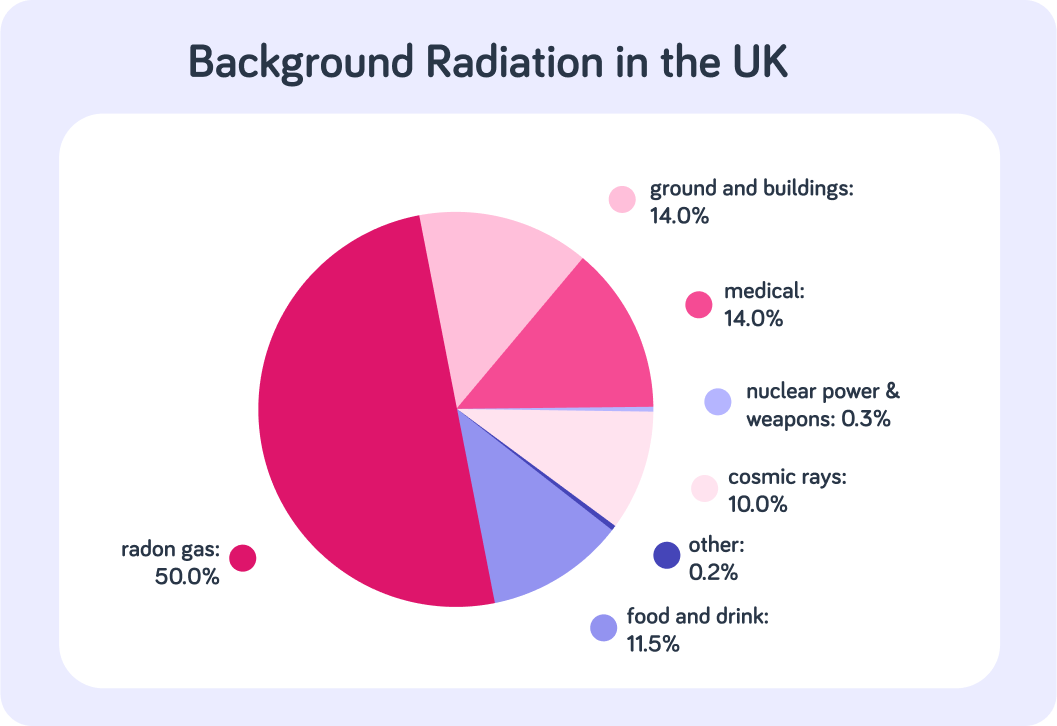YOU ARE LEARNING:
Background Radiation

Background Radiation
There is radiation all around us which comes from nature as well as some man-made sources.
This lesson looks at what we mean by background radiation and what the main sources are of natural and man-made radiation on Earth.
You might have come across the word radiation as part of studying the electromagnetic spectrum. What do you think is not a good definition of what radiation is?

So when we talk about radiation, we talk about the emission or transmission of energy in the form of waves or particles through space or through a material medium.
What do we mean when we say that radiation is ionising?

When studying radioactivity, we usually mean ionising radiation when we talk about radiation. This is because all other types of radiation are not as dangerous. Ionising radiation has the ability to add or remove electrons from an atom or molecule. This makes it dangerous! It can cause alterations in DNA, which can cause mutations and in some cases, lead to cancer.
What do you think is means that something is radioactive?

Later lessons will look at radioactive radiation in more detail. For now, what do you think might be sources of radiation? Pick all the options you think are correct.

You can select multiple answers
Radiation is around us all the time. However, the amount is very small, so it's not something we should worry about. That being said, there are some places which have more radiation than others and some occupations which lead to more exposure to radiation.
Here we can see a piechart that shows the percentage of each source of background radiation in the UK. How many are man-made or artificial sources?


You might have thought 'ground and buildings' is a man-made source.
However, this refers to the naturally occurring radioactive rock, such as granite or limestone, that is used in construction. The source itself is not man-made!

Which source is the main source of natural radiation?


Radon is a colourless, odourless, radioactive gas that is formed by the radioactive decay of small amounts of uranium that occur naturally in all rocks and soils.
14% comes from the construction materials found in the ground, such as limestone and granite. These are more abundant in some places, which makes their levels of background radiation higher, for example in Cornwall or some parts of northern Scotland.

Cosmic rays are another large source of background radiation. Where do you think they come from mainly?


So cosmic rays are actually high-energy particles which move through space at nearly the speed of light.
They mainly originate from our Sun, but they also come from outside of the solar system and from distant galaxies.

Food and drink is also a natural source of radiation.
For example, bananas have potassium in them which is very slightly radioactive!

Should we be worried about exposure to background radiation? Answer yes or no.


It is important to emphasise that background radiation is very low level radiation.
So it's not something we should worry about.

The main source of man-made background radiation is medicine. Pick the most correct statement.
A) X-rays are used in medicine. B) Gamma rays are used in medicine. C) Beta radiation is used in medicine. D) All of the above are used in medicine.


There are lots of medical uses for radiation, like radiotherapy, CT scans, X-ray imaging, and more.
These are all artificial or man-made sources of background radiation.

Nuclear weapons testing, which has mainly been phased out, is also a source of radiation, but it stays round for a long time.
Equally, nuclear power accidents are also disastrous. They cause a lot of radioactive substance to leak into the surrounding areas.

